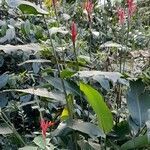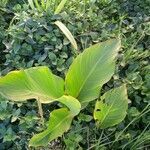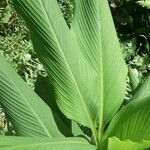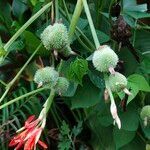Upright herb usually 1-1.5 m. tall from a horizontal branching rhizome.. Leaf-blade narrowly ovate to narrowly elliptic, ± 60 × 25 cm., base rounded to cuneate, gradually attenuate to the sheath, apex acuminate.. Inflorescence racemose, usually simple, but sometimes branched later, bearing single or paired flowers.. Bracts broadly obovate, 0.9-2 × 1 cm.. Sepals ovate, acute, 1-1.5 × 0.4-0.9 cm.. Corolla 4-5 cm. long, the lowermost 1 cm. fused into a tube, the lobes free; lobes 3-4 × 0.3-0.7 cm., usually red but sometimes with yellow markings.. Staminodes usually 3, spathulate, 4-6 × 1-1.5 cm., reddish, fused at the base, apex acute or emarginate. Labellum usually red above, yellow with red markings below, 4-5 × 0.6-1 cm., narrowly oblong, apex emarginate.. Stamen 4-5 cm. long, petaloid portion involute; anther 0.7-1 cm. long, adnate to the sterile part for one-third of its length.. Style 4-5 cm. long, reddish or yellowish.. Capsule ovoid, 2-3 cm. long, covered outside with soft spines, opening irregularly.. Seeds spherical, smooth, very dark brown, ± 0.5 cm. in diameter.
Rhizome developed, much branched. Stems stout, to 2.5 m. Leaf sheath green or purple; petiole short; leaf blade adaxially green, abaxially and at margin green or purple, ovate-oblong to oblong, 30--60 × 10--20 cm. Inflorescence a raceme of cincinni. Bracts light purple, ovate, ca. 8 mm. Flowers 1 or 2 per cincinnus. Sepals pale purplish green, lanceolate, ca. 1.5 cm. Corolla tube apricot yellow, ca. 1.5 cm; lobes erect, red to apricot yellow with purplish apex, lanceolate, ca. 4 cm. Staminodes 2(or 3), erect, red with apricot yellow base, oblanceolate, 4--5.5 cm × 7--10 mm, 1 with apex emarginate; labellum red, sometimes with yellow spots, lanceolate, ca. 4.5 cm, margin revolute, apex emarginate; fertile stamen with filament reddish apricot yellow, lanceolate, ca. 4.2 cm; anther ca. 9 mm. Ovary green, globose, ca. 6 mm in diam., warty. Style red to apricot yellow, narrow, ca. 6 cm, base adnate to staminode column. Capsule broadly ovoid, 1.2--1.8 cm. Fr. Sep--Oct. 2 n = 18.
A broad leafed plant with purple leaf sheaths. It is about 1.5 to 2.5 m high. It grows as a perennial. The stems are in clusters. The leaves are large and smooth. They are dark green but can be reddish in some varieties. The leaf base forms a sheath around the stem. The flowers are red and produced at the top of the plant. The petals are small and red and 4-10 mm wide. The fruit is a 3 celled capsule with black seeds. Underground it has a much branched root or rhizome with fattened sections covered with leaf scars. These are often light red on the outside and yellowish white inside. A clump of 15-20 suckers often develops. These starchy tubers are from 6 cm across to 15 cm long. The shape varies. The seeds are black and hard. They are 5-7 mm across.
Plants 1-3 m. tall, glabrous throughout; leaves ovate to ovate-elliptic, acute to shortly acuminate, base broadly obtuse or rounded then abruptly and shortly decurrent to the sheath, 15-50 cm. long, 9-20 cm. broad; inflorescence usually branched several times toward the base, bearing numerous paired, shortly pedi-cellate to subsessile flowers; sepals lanceolate, 0.9-1.2 cm. long; corolla 3-4 cm. long, red frequently flushed with yellow toward the base, the lobes narrowly oblong-lanceolate, narrowly acuminate, spreading, the tube about as long as the sepals; staminodia oblanceolate, 4-5 cm. long, red frequently flushed with yellow or orange at the base; capsules irregularly ellipsoid, 2-4 cm. long, 1.5-2.5 cm. broad, densely spinose-muricate.
Rhizomatous herb to 2 m tall. Leaves elliptic, acute to acuminate; lamina to 45 cm long and 25 cm wide, entire, narrowed to sheath at base. Floral bracts c. 1 cm long. Sepals 1-1.5 cm long. Corolla tube up to 1 cm long; lobes 3.5-4 cm long, sometimes unequal, erect; margins incurved. Outer staminodes 3, to 5 cm long, less than 1.5 cm wide, often unequal in size, red, or occasionally yellow or red and yellow; inner staminode to 4.5 cm long and 0.8 cm wide, recurved at apex. Petaloid filament c. 0.3-0.4 cm wide, not recurved; anther c. 1 cm long. Style c. 4 mm wide. Capsule 2-3 cm long. Seeds 5-6 mm long, black or dark brown.
Stems 1-2 m high, sturdy, glabrous, green. Leaves c. 45 cm long, oblong, green. Flowers in a lax raceme, often in pairs; bracts green, almost orbicular; sepals c. 1 cm long; petals 3-4 cm long, pinkish-red, lanceolate, acuminate. Erect staminodia 5-6 cm long, red, obovate-spathulate, entire; recurved staminode (labellum) narrower, entire, reddish-yellow, spotted red. Capsule ± globose, c. 2 × 1.5 cm, crowned by persistent sepals. Seeds globose, black.
Perennial herb, up to 1.2 m high with tall, annual stems covered by sheathing bases. Flowers with 3 upper petals red, lower 2 yellow, red-tipped and flecked.
Scarlet or orange-red flowers.
Herb 3-4 ft. high












